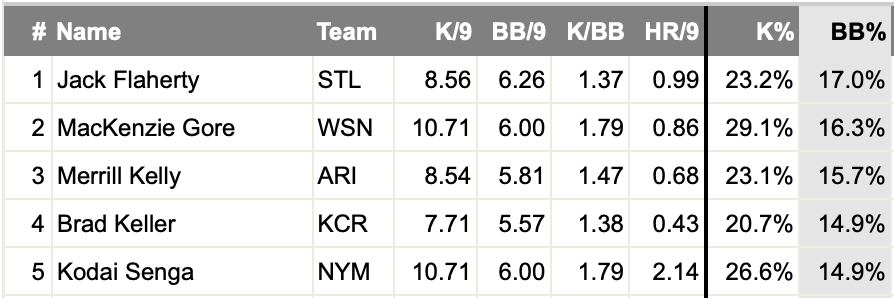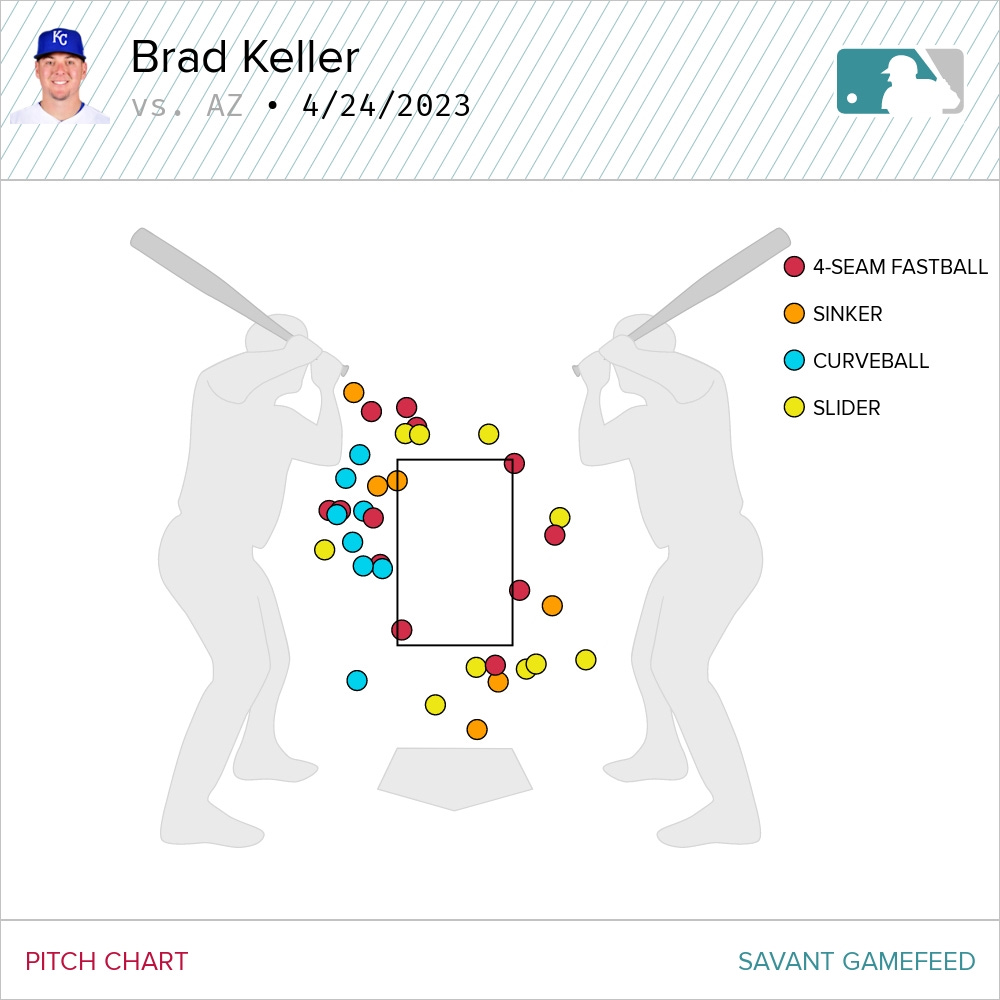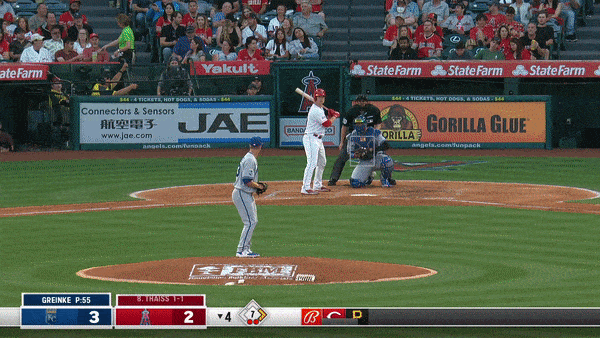Three Up, Three Down: Walk on the wild side
Keller has no control and the offense once again squanders opportunities. Also, an interesting roster move.
In a night defined by wildness, the Diamondbackss edged the Royals by a score of 5-4.
Aroldis Chapman was scored on for the first time all year, but it was an odd sequence with one out that kicked off the rally. Chapman was called for a pitch clock violation on a 1-1 count with Christian Walker at the plate. Except there was plenty of time left on the clock, so I’m not sure the reasoning behind that call. Salvador Perez had stepped out in front of the plate, but there was no time out called and Chapman was charged with a ball. It was just a confusing sequence of events that was exacerbated when Chapman, perhaps unnerved, subsequently walked the batter. After a single moved Walker to third, Nick Ahmed hit a squibber to first that Vinnie Pasquantino fielded with a backhand, but didn’t get a good grip on the ball and threw just up the line. The errant throw hit Walker as he slid across with the go-ahead—and eventual winning—run.
The Royals are 5-18.
As usual, the Royals offense was a bag of missed opportunities.
It really felt like the Royals had something cooking in the first. Bobby Witt Jr. led off the game with a deep fly out and Edward Olivares tagged a belt-high fastball on the inner black 412 feet for a solo dinger. Back to back walks to Vinnie Pasquantino and Salvador Perez had Diamondback starter Tommy Henry reeling early. He was really having difficulty locating, spraying his pitches well off the plate. On the rare occasions he was in the zone, like to Olivares, he was dangerously belt-high. Even with an offense that is consistently riding the struggle bus, the Royals needed to do more damage in that inning that just the single run.
What that inning did was let Henry off the hook. He sort of settled in after that, although he struggled to do anything with Pasquantino and Perez, the rest of the lineup was impotent against the lefty for the next couple of innings.
In the fifth they drew a pair of walks, a single and a double and were able to plate just a single run. The first caught stealing of the year when Witt broke for second on first movement against the lefty Henry with the inability to get a runner home from third with fewer than two outs were the culprits in that frame. Entering the game, the Royals had converted exactly half of their chances with runners on third and fewer than two outs, a surprisingly high rate for this offense and right at the league average. It just feels like they fail to cash in in that situation more often than not.
If you’ve read this far and are still looking for positives in the offense, how about Michael Massey, who picked up a pair of hits for the second game in a row? After his brutally slow start at the plate it’s good to see a flicker of life. But he was the only guy in the bottom half of the lineup to put together good at bats on Monday. The lineup remains frustratingly imbalanced with Perez and Pasquantino doing the heavy lifting in the top half on Monday, going a combined 5-8 with two walks. The rest of the line up was 5-28 with three walks.
Walks have officially become an issue for Brad Keller. Entering the game on Monday, he was walking over five and a half per nine, which translates to issuing free passes to 15 percent of all batters he faced. Among pitchers who had thrown at least 20 innings this year, Keller had the fourth-highest walk rate.
Then on Monday he walked the leadoff hitter in each of the first three innings, couldn’t throw any of his pitches for strikes and worked behind in the count practically all night. Yeah, yeah, yeah…tip of the cap for grinding and gutting through four innings without your best stuff. Whatever. It was brutal to watch.
Keller threw a first-pitch strike to 12 of 21 batters he faced. Frankly, that number surprised me. However, there were multiple instances where he jumped ahead 0-1 and then uncorked four consecutive out of the zone. It was that kind of night.
In his first three innings of work, Keller threw a whopping 73 pitches. Only 36 were strikes. Brutal. This is the pitch chart on the balls through three innings:
He was missing on the arm-side with his curve and was spraying his four-seamer all over the place. You’ll live with the sliders down and out of the zone—that’s a swing and miss area if he’s ahead in the count—but was inexplicably leaving the slider up as well. These were easy takes for the Diamondback hitters.
Keller’s night was mercifully complete after four. His final line: 4 IP, 4 H, 4 ER, 6 BB, 2 SO. He threw 95 pitches with 51 going for strikes.
Ahead of Monday’s game, the Royals reinstated Franmil Reyes from the paternity list and optioned Nate Eaton to Omaha. Freddy Fermin, the initial recall to replace Reyes remains on the 26-man roster.
As usual with a move like this, there’s quite a bit to unpack. Let’s start with Eaton. He’s clearly one of the Royals’ better defenders in the outfield. He’s also shown he can play third. The arm can fire from anywhere. However, the defense doesn’t come close to covering for the offense. With Matt Quatraro committed to finding time for every player on the roster, Eaton is still the 26th man. He’s had just 25 plate appearances and has provided absolutely nothing with the bat. It’s a harsh assessment, but when you’re hitting .040/.040/.040, the numbers don’t lie. Eaton has one hit and hasn’t walked while striking out 13 times.
I hope that in keeping Fermin, ostensibly the third catcher on the roster, it signals the Royals are committed to MJ Melendez as their regular right fielder. This would be absolutely the correct move. Melendez has improved by leaps and bounds over the adventurous fielding we saw last summer. He’s not necessarily smooth out there, but he’s doing well enough that he deserves continued reps at the position. The limited defensive metrics confirm this. He’s been worth one Outs Above Average, one of 12 right fielders to have a positive number in the early going. Going a little deeper, Statcast has his reaction time as a negative, which is understandable as he’s still learning to read the ball off the bat. His routes are a net positive as once he draws a bead on the ball, he’s getting there in a direct fashion. Throw it all together and you get an outfielder who is plus 0.7 feet over average in getting a jump. That will work. (Incidentally, it’s the same Jump as Kyle Isbel, who has a fantastic reaction time but less desirable routes to the ball.) The eye test will confirm the improvement of Melendez’s defense as well.
The above was from Saturday in Anaheim. Statcast has this play as a 99 percent catch probability, but I respectfully disagree. It’s a liner, over Melendez’s head and at twilight. It’s not a simple play. Yet Melendez tracks it well and makes the catch. Just the latest example of his maturation as an outfielder.
The pragmatist school of thought would be that since Melendez’s back tightened up on Sunday—and he was out of the lineup on Monday—the Royals need to keep Fermin as the backup to Perez. This move is just for cover and has nothing to do with Melendez’s defense in right field. Once Melendez is cleared and back in the lineup, Fermin will return to Omaha. Although they would probably keep Fermin around even once Meledez is back on the field, just as a precaution.
I guess we’ll learn more of the Royals intentions of how they will handle their roster in the next few days. As I said…a lot to unpack.








For a large majority of games this season, RISP has stood for Royals Insist on Stranding People. Monday night vs Arizona continued that trend with only a very occasional exception.
I have been pretty happy with MJ out in the field. Not really worried about the bat, maybe I should be, but I guess I still have a good first impression from last year.